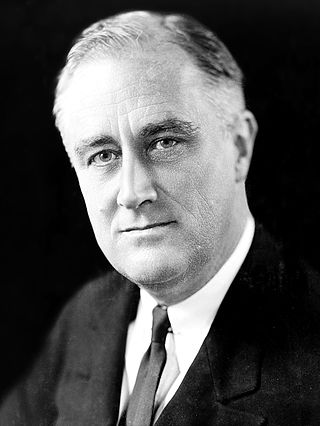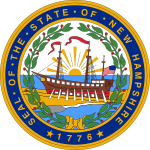
The 1932 United States presidential election was the 37th quadrennial presidential election, held on Tuesday, November 8, 1932. The election took place against the backdrop of the Great Depression. The incumbent Republican President Herbert Hoover was defeated in a landslide by Democrat Franklin D. Roosevelt, the governor of New York and the vice presidential nominee of the 1920 presidential election. Roosevelt was the first Democrat in 80 years to simultaneously win an outright majority of the electoral college and popular vote, a feat last accomplished by Franklin Pierce in 1852, as well as the first Democrat in 56 years to win a majority of the popular vote, which was last done by Samuel J. Tilden in 1876. Roosevelt was the last sitting governor to be elected president until Bill Clinton in 1992. Hoover became the first incumbent president to lose an election to another term since William Howard Taft in 1912, and the last to do so until Gerald Ford lost 44 years later. The election marked the effective end of the Fourth Party System, which had been dominated by Republicans. It was the first time since 1916 that a Democrat was elected president.

The New Hampshire Senate is the upper house of the New Hampshire General Court, alongside the lower New Hampshire House of Representatives. The Senate has been meeting since 1784. The Senate consists of 24 members representing Senate districts based on population. There are 14 Republicans and 10 Democrats currently serving in the Senate.
Elections for the Massachusetts Governor's Council were held on November 7, 2006. Candidates from the Democratic Party were elected or re-elected to all eight districts.
The Massachusetts Republican Party (MassGOP) is the Massachusetts branch of the U.S. Republican Party.
The New Hampshire Democratic Party (NHDP) is the affiliate of the Democratic Party in the U.S. state of New Hampshire. Its chair is Raymond Buckley, and its vice chairs are Martha Fuller Clark and Bette Lasky. The most recent Democratic governor was Maggie Hassan, who served from 2013 to 2017.

The 1988 United States presidential election in Massachusetts took place on November 8, 1988, as part of the 1988 United States presidential election, which was held throughout all 50 states and D.C. Voters chose 13 representatives, or electors to the Electoral College, who voted for president and vice president.

The 1968 United States presidential election in Massachusetts took place on November 5, 1968, as part of the 1968 United States presidential election, which was held throughout all 50 states and D.C. Voters chose 14 representatives, or electors to the Electoral College, who voted for president and vice president.

The 1936 United States presidential election in Massachusetts took place on November 3, 1936, as part of the 1936 United States presidential election, which was held throughout all contemporary 48 states. Voters chose 17 representatives, or electors to the Electoral College, who voted for president and vice president.

The 1920 United States presidential election in Alabama took place on November 2, 1920, as part of the 1920 general election, in which all 48 states participated. Alabama voters chose twelve electors to represent them in the Electoral College via popular vote pitting Democratic nominee James M. Cox and his running mate, Assistant Secretary of the Navy Franklin Roosevelt, against Republican challenger U.S. Senator Warren G. Harding and his running mate, Governor Calvin Coolidge.

The 1964 United States presidential election in New Hampshire took place on November 5, 1964, as part of the 1964 United States presidential election, which was held throughout all 50 states and D.C. Voters chose four representatives, or electors to the Electoral College, who voted for president and vice president.

The 1912 United States presidential election in Wisconsin was held on November 5, 1912 as part of the 1912 United States presidential election. State voters chose 13 electors to the Electoral College, who voted for president and vice president.

The 1912 United States presidential election in Maine took place on November 5, 1912, as part of the 1912 United States presidential election which was held throughout all contemporary 48 states. Voters chose six representatives, or electors to the Electoral College, who voted for president and vice president. Maine was won by the Democratic nominees, New Jersey Governor Woodrow Wilson and Indiana Governor Thomas R. Marshall. Wilson and Marshall defeated incumbent President William Howard Taft, and his running mate Vice President James S. Sherman and Progressive Party candidates, former President Theodore Roosevelt and his running mate California Governor Hiram Johnson.

The 1914 Wisconsin gubernatorial election was held on November 3, 1914.

The 1914 Massachusetts gubernatorial election took place on November 3, 1914. Democratic Governor David I. Walsh defeated the Republican, Samuel W. McCall, and the Progressive, Joseph Walker, and won reelection with 45.93% of the vote.

The 1912 Massachusetts gubernatorial election took place on November 5, 1912. Democratic Governor Eugene Foss defeated the Republican candidate Joseph H. Walker and Progressive candidate Charles S. Bird.

The 1912 Rhode Island gubernatorial election was held on November 5, 1912. Incumbent Republican Aram J. Pothier defeated Democratic nominee Theodore F. Green with 43.67% of the vote.

The 1912 Indiana gubernatorial election was held on November 5, 1912. Democratic nominee Samuel M. Ralston defeated Progressive nominee Albert J. Beveridge and Republican nominee Winfield T. Durbin with 42.95% of the vote. The vote splitting between the Republican and Progressive nominees benefited Ralston the Democrat tremendously in this election.

The 1932 New York City special mayoral election was held on November 8. It was triggered by the resignation of incumbent Democratic Mayor Jimmy Walker on September 1, after his administration had become embroiled in scandal. Democratic nominee John P. O'Brien easily defeated Republican Lewis H. Pounds and Socialist Morris Hillquit. Acting Mayor Joseph V. McKee also featured as a write-in candidate. Minor candidates included Communist William L. Patterson and Socialist Labor candidate Olive Johnson.
The 1860 Massachusetts gubernatorial election was held on November 6. Incumbent Republican Governor Nathaniel Banks did not run for re-election to a fourth term. He was succeeded by Republican John Albion Andrew, a radical abolitionist.

The 1912 Wisconsin gubernatorial election was held on November 5, 1912.



















